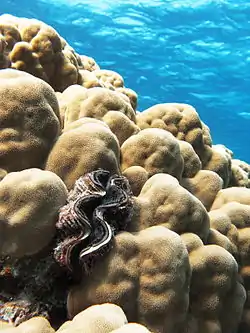Porites nodifera
Porites nodifera, also known as dome coral, is a species of stony coral in the Poritidae family.[1][2][3]
| Porites nodifera | |
|---|---|
 | |
| Porites nodifera with a tridacna clam | |
| Scientific classification | |
| Kingdom: | Animalia |
| Phylum: | Cnidaria |
| Class: | Anthozoa |
| Order: | Scleractinia |
| Family: | Poritidae |
| Genus: | Porites |
| Species: | P. nodifera |
| Binomial name | |
| Porites nodifera Klunzinger, 1879 | |
| Synonyms | |
| |
It was first described by Carl Benjamin Klunzinger, a German physician and zoologist active in the Red Sea region in the 1860s, and classifying its species in the 1870s and 1880s.
Distribution
Porites nodifera is native to the northwestern Indian Ocean, including the Red Sea, Gulf of Aden, and Persian Gulf. It is found in shallow water, generally at depths less than 5 metres (16 ft), but up to 15 metres (49 ft) deep. It is tolerant of high salinities.
In the Persian Gulf, Porites nodifera and other Porites species are the dominant corals present. This may be as a result of coral bleaching affecting Acropora coral species to a greater extent, and Porites filling in resulting gaps in the reef.[4]
Conservation
This coral is an IUCN Red List Least concern species currently. The most important known threat for this species is the extensive reduction of coral reef habitat due to a combination of threats, including climate change and ocean acidification.
In 2020, a study conducted in the Red Sea suggested that this species has a high tolerance to the increasing environmental temperature, and perhaps, will be used by other species as a refuge due to this ability.[5]
References
- "Porites nodifera". ARKive. 2013-03-30. Archived from the original on 2014-03-06. Retrieved 2013-04-03.
- "Porites nodifera". iucnredlist.org. January 2008. Retrieved 2013-04-03.
- "Corals of the World Factsheet and images - Porites nodifera". coral.aims.gov.au. 2011-06-24. Retrieved 2013-04-03.
- Riegl, Bernhard; Purkis, Sam J. (2012). Coral Reefs of the Gulf: Adaptation to Climatic Extremes. Springer Science & Business Media. p. 75. ISBN 978-94-007-3008-3.
- Osman, Eslam O. (2020). "Coral microbiome composition along the northern Red Sea suggests high plasticity of bacterial and specificity of endosymbiotic dinoflagellate communities". Microbiome. BMC. 8 (1): 8. doi:10.1186/s40168-019-0776-5. PMC 6996193. PMID 32008576.